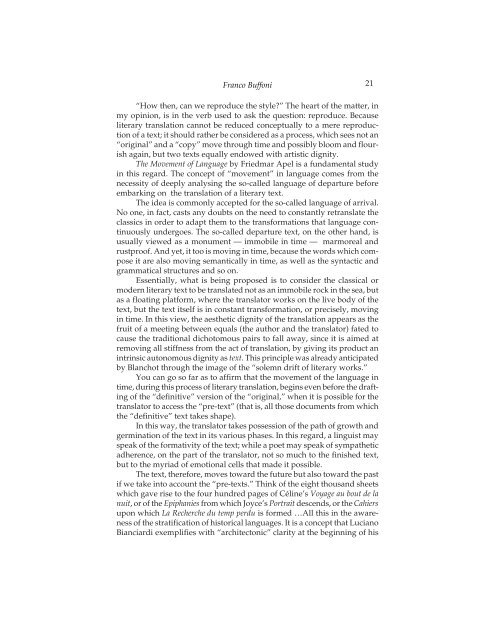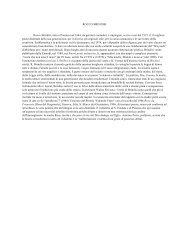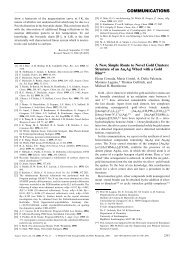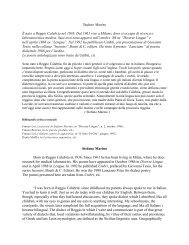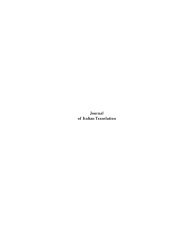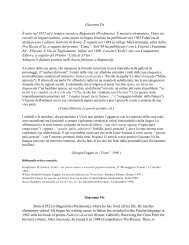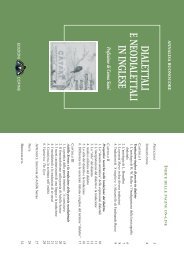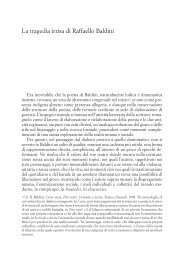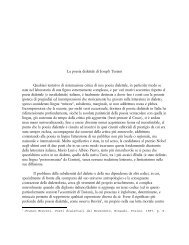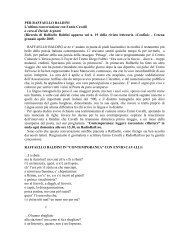Journal of Italian Translation
Journal of Italian Translation
Journal of Italian Translation
Create successful ePaper yourself
Turn your PDF publications into a flip-book with our unique Google optimized e-Paper software.
Franco Buffoni<br />
“How then, can we reproduce the style?” The heart <strong>of</strong> the matter, in<br />
my opinion, is in the verb used to ask the question: reproduce. Because<br />
literary translation cannot be reduced conceptually to a mere reproduction<br />
<strong>of</strong> a text; it should rather be considered as a process, which sees not an<br />
“original” and a “copy” move through time and possibly bloom and flourish<br />
again, but two texts equally endowed with artistic dignity.<br />
The Movement <strong>of</strong> Language by Friedmar Apel is a fundamental study<br />
in this regard. The concept <strong>of</strong> “movement” in language comes from the<br />
necessity <strong>of</strong> deeply analysing the so-called language <strong>of</strong> departure before<br />
embarking on the translation <strong>of</strong> a literary text.<br />
The idea is commonly accepted for the so-called language <strong>of</strong> arrival.<br />
No one, in fact, casts any doubts on the need to constantly retranslate the<br />
classics in order to adapt them to the transformations that language continuously<br />
undergoes. The so-called departure text, on the other hand, is<br />
usually viewed as a monument — immobile in time — marmoreal and<br />
rustpro<strong>of</strong>. And yet, it too is moving in time, because the words which compose<br />
it are also moving semantically in time, as well as the syntactic and<br />
grammatical structures and so on.<br />
Essentially, what is being proposed is to consider the classical or<br />
modern literary text to be translated not as an immobile rock in the sea, but<br />
as a floating platform, where the translator works on the live body <strong>of</strong> the<br />
text, but the text itself is in constant transformation, or precisely, moving<br />
in time. In this view, the aesthetic dignity <strong>of</strong> the translation appears as the<br />
fruit <strong>of</strong> a meeting between equals (the author and the translator) fated to<br />
cause the traditional dichotomous pairs to fall away, since it is aimed at<br />
removing all stiffness from the act <strong>of</strong> translation, by giving its product an<br />
intrinsic autonomous dignity as text. This principle was already anticipated<br />
by Blanchot through the image <strong>of</strong> the “solemn drift <strong>of</strong> literary works.”<br />
You can go so far as to affirm that the movement <strong>of</strong> the language in<br />
time, during this process <strong>of</strong> literary translation, begins even before the drafting<br />
<strong>of</strong> the “definitive” version <strong>of</strong> the “original,” when it is possible for the<br />
translator to access the “pre-text” (that is, all those documents from which<br />
the “definitive” text takes shape).<br />
In this way, the translator takes possession <strong>of</strong> the path <strong>of</strong> growth and<br />
germination <strong>of</strong> the text in its various phases. In this regard, a linguist may<br />
speak <strong>of</strong> the formativity <strong>of</strong> the text; while a poet may speak <strong>of</strong> sympathetic<br />
adherence, on the part <strong>of</strong> the translator, not so much to the finished text,<br />
but to the myriad <strong>of</strong> emotional cells that made it possible.<br />
The text, therefore, moves toward the future but also toward the past<br />
if we take into account the “pre-texts.” Think <strong>of</strong> the eight thousand sheets<br />
which gave rise to the four hundred pages <strong>of</strong> Céline’s Voyage au bout de la<br />
nuit, or <strong>of</strong> the Epiphanies from which Joyce’s Portrait descends, or the Cahiers<br />
upon which La Recherche du temp perdu is formed …All this in the awareness<br />
<strong>of</strong> the stratification <strong>of</strong> historical languages. It is a concept that Luciano<br />
Bianciardi exemplifies with “architectonic” clarity at the beginning <strong>of</strong> his<br />
21


